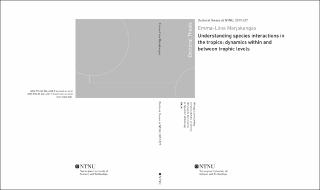Understanding species interactions in the tropics: dynamics within and between trophic levels
Doctoral thesis
Permanent lenke
http://hdl.handle.net/11250/2640204Utgivelsesdato
2019Metadata
Vis full innførselSamlinger
- Institutt for biologi [2612]
Sammendrag
Knowledge on how and why species interact with each other can provide invaluable insight into understanding the many-fold effects that the anthropogenic pressures have on biodiversity and ecosystem functioning. Multiple factors, including species’ co-occurrences, traits and the abiotic environment, define the pairwise interactions and the structure of interaction networks as a whole. These factors function both within trophic levels and between them. In this thesis, I aim to increase the basic understanding of the processes behind species interactions within and between trophic levels. I focus on interactions of tropical tree species and their seed dispersing mutualists in South America. I combine species distribution models and network analyses to study interaction networks at a large spatial scale. In general, I find that interaction networks within and between trophic levels are shaped by effects of assembly processes on species communities within trophic levels, and by effects of interaction assembly processes on the interspecific interaction links, the latter having a larger influence on the overall network structure. Within tropical tree communities, environmental filtering was the main driver of species’ co-occurrences, whereas species’ traits or relatedness did not influence their co-occurrences. Between tropical trees and seed dispersing animals, forest fragmentation in form of area, rather than edge effect, decreased the quantity and quality of interactions. I used predicted tree-animal networks to prioritize species and areas for seed disperser reintroductions in the fragmented and defaunated Atlantic Forest. I found that reintroducing common generalist, as well as some rare specialist, bird species would be the most efficient way to reinstate seed dispersal function in the forest. Overall, co-occurrence and interaction patterns showed significant spatial variation across South America, indicating existence of large-scale biogeographical and anthropogenic processes. In conclusion, understanding the different components of interaction networks separately allows understanding and protecting interaction networks as a whole.
Består av
Paper 1: Marjakangas E., Muñoz G., Turney S., and Lessard J.-P. A framework linking trait-based processes to the assembly of bipartite networks. Manuscript.Paper 2: Marjakangas E., Ovaskainen O., Abrego N., Grøtan V., de Oliveira A.A., Prado P.I., and de Lima R.A.F. Co-occurrences of tropical trees: disentangling abiotic and biotic forces. Submitted manuscript.
Paper 3: Marjakangas E., Abrego N., Grøtan V., de Lima R.A.F., Bello C., Bovendorp R.S., Culot L., Hasui É., Lima F., Muylaert R.L., Niebuhr B.B., de Oliveira A.A., Pereira L.A., Prado P.I., Stevens R.D., Vancine M.H., Ribeiro M.C., Galetti M., and Ovaskainen O. Fragmented tropical forests lose mutualistic plant-animal interactions. Submitted revised manuscript. Final version available at: http://dx.doi.org/10.1111/ddi.13010
Paper 4: Marjakangas, Emma-Liina; Genes, Luísa; Pires, Mathias M.; Fernandez, Fernando A.S.; de Lima, Renato A.F.; de Oliveira, Alexandre A.; Ovaskainen, Otso; Pires, Alexandra S.; Prado, Paulo I.; Galetti, Mauro. Estimating interaction credit for trophic rewilding in tropical forests. Philosophical Transactions of the Royal Society of London. Biological Sciences 2018 ;Volum 373.(1761) s. – Not included du to copyright restrictions. Available at: http://dx.doi.org/10.1098/rstb.2017.0435
